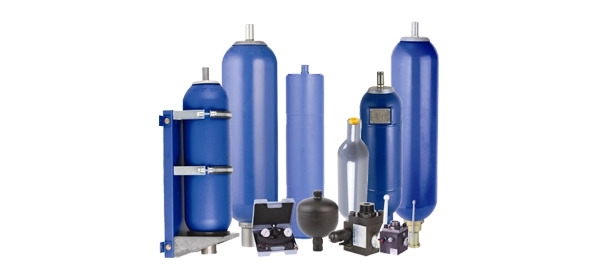Bladder accumulators are hydraulic components designed to store pressurized fluid. They consist of a cylindrical shell typically made from steel, containing an elastomeric bladder or bag inside. This bladder separates the gas and fluid chambers within the accumulator. The gas pre-charge, usually nitrogen, exerts pressure on the bladder, compressing it and storing potential energy in the form of compressed gas.
Applications Across Industries
Bladder accumulators find application in diverse industrial sectors, each benefiting from their unique capabilities:
1. Industrial Manufacturing:
- Hydraulic Press Systems: Used for buffering hydraulic shock, reducing wear on pumps, and maintaining consistent pressure during operation.
- Injection Molding Machines: Provide rapid and precise pressure adjustments, ensuring smooth and efficient molding processes.
2. Oil and Gas:
- Drilling Operations: Absorb hydraulic shocks and pressure fluctuations, enhancing equipment longevity and operational safety.
- Subsea Equipment: Compact design and reliability make bladder accumulators ideal for offshore applications.
3. Automotive and Transportation:
- Suspension Systems: Manage ride comfort and stability by absorbing road shocks and vibrations.
- Hydraulic Braking Systems: Ensure responsive and reliable braking performance under varying load conditions.
4. Aerospace:
- Flight Control Systems: Provide emergency backup power and smooth out hydraulic pressure fluctuations for critical flight control operations.
- Landing Gear: Absorb shock during landing, enhancing passenger comfort and aircraft longevity.
Benefits of Bladder Accumulators
The advantages of bladder accumulators contribute significantly to their widespread adoption:
1. Energy Storage and Efficiency:
- Store hydraulic energy for immediate use, reducing peak power demands on hydraulic pumps.
- Enhance system efficiency by minimizing energy losses associated with pressure fluctuations.
2. Compact and Lightweight Design:
- Compared to piston accumulators, bladder accumulators offer a more compact form factor, making them easier to integrate into existing systems.
- Lightweight construction reduces overall system weight, crucial in aerospace and automotive applications.
3. Maintenance and Reliability:
- Elastomeric bladders are durable and resistant to fatigue, ensuring long service life with minimal maintenance requirements.
- Reliable performance in harsh environments, including high temperatures and corrosive conditions.
4. Safety and Operational Flexibility:
- Provide a reliable source of emergency hydraulic power, crucial in safety-critical applications such as emergency braking systems.
- Enable precise pressure control and response, enhancing overall system safety and operational flexibility.
Working Principle
The operation of bladder accumulators revolves around the interaction between gas and fluid dynamics:
- Gas Pre-Charge: Nitrogen or another inert gas is pre-charged into the accumulator at a specified pressure. This pre-charge pressure determines the initial potential energy stored in the accumulator.
- Fluid Compression: When hydraulic fluid enters the accumulator, the elastomeric bladder compresses, allowing the gas volume to decrease while maintaining a constant pressure.
- Energy Storage and Release: As fluid pressure fluctuates within the system, the bladder expands or contracts, absorbing excess fluid or releasing stored energy to maintain stable pressure levels.
Considerations for Selection and Maintenance
When selecting bladder accumulators for specific applications, several factors should be considered:
- Pressure Rating: Ensure the accumulator can handle maximum system pressures without compromising safety or performance.
- Fluid Compatibility: Verify compatibility with hydraulic fluids used in the system to prevent degradation or failure.
- Temperature and Environment: Assess operating conditions to select materials and configurations that withstand environmental extremes and corrosive atmospheres.
- Installation and Mounting: Proper installation ensures optimal performance and safety, minimizing potential risks during operation.
Regular maintenance, including periodic inspection of bladder integrity and gas pre-charge pressure, is essential to prolonging accumulator life and ensuring consistent performance over time.
Future Trends and Innovations
The evolution of bladder accumulator technology continues to focus on enhancing performance, efficiency, and reliability:
- Material Advancements: Research into new elastomeric materials aims to improve durability and compatibility with a broader range of fluids.
- Integration with Smart Systems: Incorporation of sensors and IoT capabilities enables real-time monitoring of pressure and performance, facilitating predictive maintenance and enhancing operational efficiency.
- Environmental Sustainability: Development of eco-friendly gas pre-charge alternatives to minimize environmental impact.
Conclusion
Bladder accumulators represent a critical component in hydraulic systems across various industries, offering unmatched versatility, efficiency, and reliability. By understanding their applications, benefits, and working principles, engineers and operators can leverage bladder accumulators to enhance system performance, improve safety, and extend equipment lifespan. As technological advancements continue, bladder accumulators will undoubtedly play an integral role in shaping the future of hydraulic and pneumatic applications worldwide.



